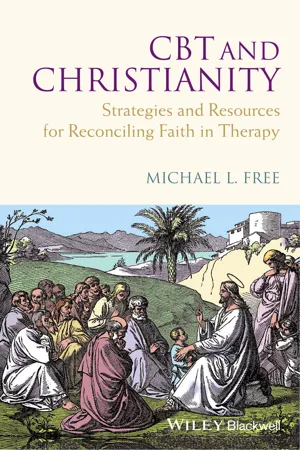
CBT and Christianity
Strategies and Resources for Reconciling Faith in Therapy
- English
- ePUB (mobile friendly)
- Available on iOS & Android
About this book
"A surprisingly satisfying read that refreshed my perspective on, and deepened my understanding of, two topics that have long seemed overly familiar. This work underscores how much of contemporary thinking has been anticipated by the ancients or just how much 'new thinking' is a recapitulation of the old, but does so in a thoroughly original way."
Murray J. Dyck, PhD, Professor of Clinical Psychology, Griffith University
While cognitive behavioural therapy (CBT) is an empirically supported treatment, many behavioural and analytical psychotherapists also recognize the healing potential of religious belief. CBT and Christianity offers CBT therapists an authoritative, practical, and comprehensive resource for counselling clients with an allegiance to the Christian faith. This innovative new treatment approach compares the teachings of Jesus to contemporary cognitive and mindfulness-based therapies, describing a variety of successful assessment and treatment approaches with Christian clients by incorporating the teachings of Jesus into logical thinking, schema modification, and committed behaviour change. Clarity is further enhanced through a variety of specific examples, descriptions of generic methods, and supplemental resources provided by the author. By combining effective treatments with sensitivity to religious convictions, CBT and Christianity offers innovative insights into the spiritual and psychological well-being of clients with Christian beliefs.
Frequently asked questions
- Essential is ideal for learners and professionals who enjoy exploring a wide range of subjects. Access the Essential Library with 800,000+ trusted titles and best-sellers across business, personal growth, and the humanities. Includes unlimited reading time and Standard Read Aloud voice.
- Complete: Perfect for advanced learners and researchers needing full, unrestricted access. Unlock 1.4M+ books across hundreds of subjects, including academic and specialized titles. The Complete Plan also includes advanced features like Premium Read Aloud and Research Assistant.
Please note we cannot support devices running on iOS 13 and Android 7 or earlier. Learn more about using the app.
Information
Part 1
Rationale for the Use of the Teachings of Jesus in CBT
1
Introduction
Topics in Chapter 1
- A historical view of spirituality, religion and psychotherapy
- The development and dominance of cognitive therapy as a psychotherapy
- The importance of Christianity in the West
- The appreciation of the role of non-specific factors in psychotherapy
- Interest in the Buddhist technique of ‘mindfulness’
- Findings relating religious adherence to positive mental and physical health
- The growing respect for cultural and individual differences
- The decline of logical positivism and the rise of postmodernism and social constructionist theory
- The question of a logical connection between cognitive therapy and the teachings of Jesus
- A general outline of the book
A historical view of spirituality, religion and psychotherapy
The development and dominance of cognitive therapy as a psychotherapy
Cognitive therapy is a psychosocial (both psychological and social) therapy that assumes that faulty thought patterns (called cognitive patterns) cause maladaptive behavior and emotional responses. The treatment focuses on changing thoughts in order to solve psychological and personality problems. Behavior therapy is also a goal-oriented, therapeutic approach, and it treats emotional and behavioral disorders as maladaptive learned responses that can be replaced by healthier ones with appropriate training. Cognitive-behavioral therapy (CBT) integrates features of behavior modification into the traditional cognitive restructuring approach.(Encyclopedia of Mental Disorders, n.d.)
Pure CBT – as opposed to the elements of it many of us employ in our practices – has five components
- Psychoeducation
- Breathing retraining
- Cognitive restructuring
- Exposure
- Relapse prevention
The importance of Christianity in the West
Table of contents
- Cover
- Title page
- Table of Contents
- List of Figures
- List of Boxes
- List of Tables
- About the Author
- Author’s Preface
- Part 1: Rationale for the Use of the Teachings of Jesus in CBT
- Part 2: Approach to Using the Teachings of Jesus in CBT with Christians
- Part 3: Resources for Using the Teachings of Jesus in CBT with Christians
- Appendix 1
- Appendix 2
- Appendix 3
- References
- Index
- End User License Agreement